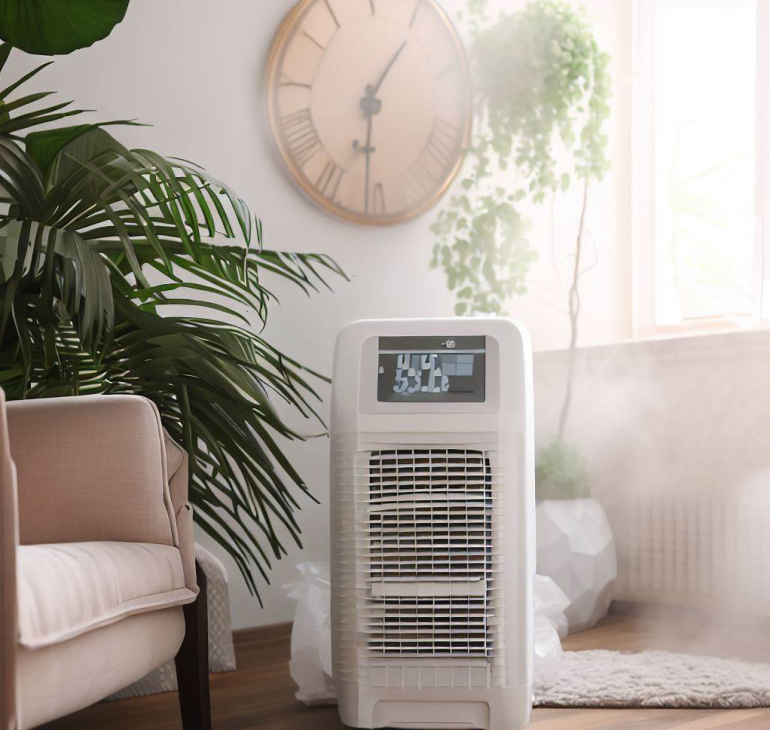The best time to use a dehumidifier is during spring, summer, and early fall, when humidity levels are high. In winter, it’s best to turn it off and store it to prevent damage from cold temperatures.
Managing humidity properly improves air quality, reduces mold risks, and increases home comfort. This guide explains when and how to use a dehumidifier for maximum efficiency, cost savings, and healthier indoor air.
Best Time to Use a Dehumidifier for Cost Efficiency
The best time to run a dehumidifier for maximum cost efficiency is during the late evening or early morning when electricity rates are lower, and humidity levels are naturally dropping.
Key Factors for Cost-Effective Use:
- Run it after moisture-heavy activities like showering, cooking, or doing laundry to prevent damp air buildup.
- Use energy-efficient models with smart sensors to adjust humidity levels automatically.
- Take advantage of off-peak electricity hours to reduce costs.
- Maintain a stable indoor humidity level (40%-50%) to prevent excessive energy consumption.
By optimizing when and how you use your dehumidifier, you can reduce electricity bills while maintaining a comfortable and healthy indoor environment.
Best Time of Day to Minimize Moisture from Daily Activities
The most effective time to use a dehumidifier to control moisture from daily activities is in the morning and early afternoon, when natural humidity levels rise due to indoor activities like cooking, showering, and laundry.
Best Strategies for Moisture Control:
- Run your dehumidifier immediately after high-humidity activities (e.g., after a shower or cooking).
- Use ventilation (turn on exhaust fans or open windows briefly).
- Keep doors closed in rooms with high moisture to prevent spread.
- Adjust settings based on humidity sensors to maintain a stable level (40%-50%).
By running a dehumidifier strategically, you can prevent mold growth, reduce allergens, and maintain a comfortable indoor climate while optimizing energy use.
Best Time of Day to Use a Dehumidifier for Room Drying
The best time to use a dehumidifier for room drying is right after activities that increase indoor humidity, such as showering, cooking, or doing laundry. This prevents moisture buildup and improves air quality.
Optimal Strategies for Room Drying:
- Use it immediately after high-humidity activities to prevent condensation.
- Maintain indoor humidity at 40%-50% for optimal comfort and mold prevention.
- Run it during off-peak electricity hours (late evening or early morning) for energy efficiency.
- Adjust settings based on seasonality—continuous use in summer, intermittent in winter.
By following these steps, you can maximize drying efficiency, reduce electricity costs, and maintain a healthier indoor environment.
Best Season to Use a Dehumidifier
The most effective seasons to use a dehumidifier are spring, summer, and early fall, when humidity levels are highest.
Seasonal Guide for Dehumidifier Use:
- Spring & Summer: Use daily to combat high humidity and prevent mold.
- Fall: Run as needed, especially in damp regions.
- Winter: Reduce usage unless condensation or mold growth occurs.
By adjusting dehumidifier use seasonally, you improve air quality, reduce allergens, and lower energy costs.
When to Avoid Using a Dehumidifier
While dehumidifiers help reduce excess moisture, there are situations when using one is unnecessary or even counterproductive:
When NOT to Use a Dehumidifier:
- In winter (cold temperatures): Running a dehumidifier in very cold conditions can freeze internal components and reduce efficiency.
- When indoor humidity is already low (<30%): Overuse can cause excessively dry air, leading to respiratory issues and skin irritation.
- In well-ventilated or naturally dry areas: If a room has good airflow and no moisture problems, a dehumidifier isn’t needed.
- If mold is already present: Dehumidifiers prevent mold growth, but they don’t remove existing mold. Affected areas should be treated before using the device.
- When energy consumption outweighs benefits: If electricity costs are high and humidity is manageable with ventilation, alternative methods may be preferable.
By knowing when to avoid using a dehumidifier, you can save energy, reduce unnecessary wear on the unit, and maintain optimal indoor air quality.
Conclusion & Final Tips for Efficient Dehumidifier Use
Using a dehumidifier effectively reduces indoor humidity by up to 50%, helping prevent mold, improve air quality, and enhance comfort. To get the most out of your unit, follow these key tips:
Best Practices for Dehumidifier Efficiency:
- Run it during optimal hours—morning and late afternoon—to control humidity levels efficiently.
- Set the correct humidity (40%-50%) to balance air moisture without over-drying.
- Regular maintenance matters—clean filters, check drainage, and empty the water tank as needed.
- Use energy-efficient models with smart sensors to reduce electricity costs.
By following these guidelines, you can maximize performance, save on energy bills, and create a healthier living space.

